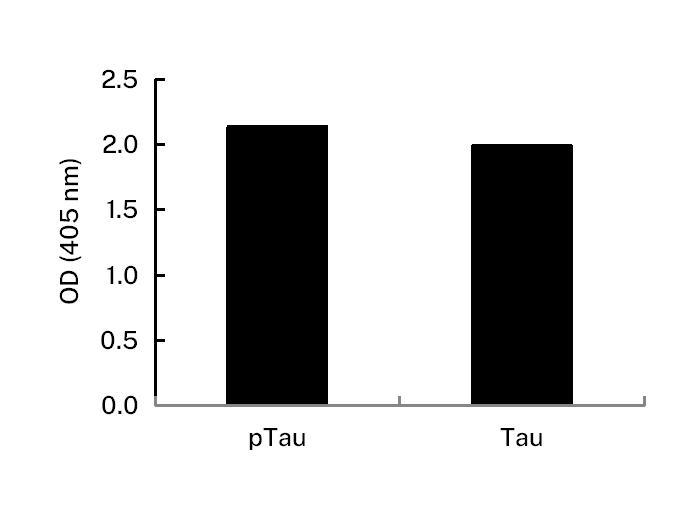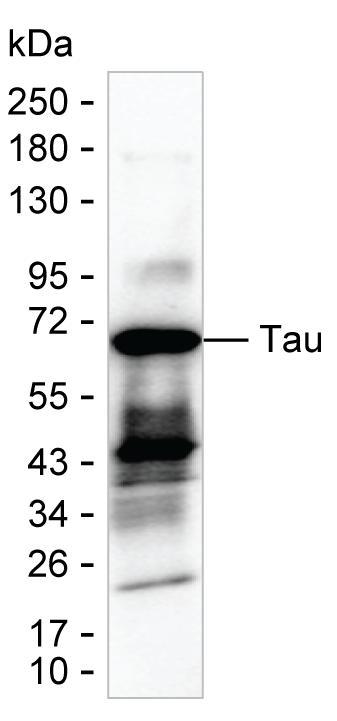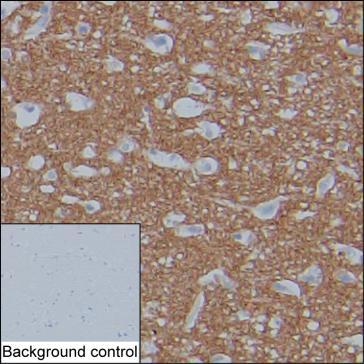


| WB | 咨询技术 | Human,Mouse,Rat |
| IF | 咨询技术 | Human,Mouse,Rat |
| IHC | 1/50-1/250 | Human,Mouse,Rat |
| ICC | 技术咨询 | Human,Mouse,Rat |
| FCM | 咨询技术 | Human,Mouse,Rat |
| Elisa | 咨询技术 | Human,Mouse,Rat |
| Host/Isotype | Mouse IgG2a |
| Antibody Type | Primary antibody |
| Storage | Store at 4°C short term. Aliquot and store at -20°C long term. Avoid freeze/thaw cycles. |
| Species Reactivity | Human |
| Immunogen | Purified recombinant fragment of human Tau |
| Formulation | Purified antibody in PBS with 0.05% sodium azide |
+ +
以下是关于Tau抗体的3篇代表性文献名称、作者及摘要内容的简要概括:
---
1. **文献名称**:*Tau-targeting therapies for Alzheimer disease: current status and future directions*
**作者**:Hampel H, et al.
**摘要**:综述了Tau蛋白在阿尔茨海默病中的作用,总结了当前靶向Tau的抗体疗法的研究进展,包括被动免疫疗法和诊断生物标志物的开发,强调抗体在清除病理性Tau蛋白和减缓神经退行中的潜力。
---
2. **文献名称**:*Abnormal phosphorylation of the microtubule-associated protein tau in Alzheimer cytoskeletal pathology*
**作者**:Iqbal K, Grundke-Iqbal I.
**摘要**:早期经典研究,首次揭示Tau蛋白异常磷酸化是阿尔茨海默病神经原纤维缠结(NFTs)形成的核心机制,为后续开发磷酸化Tau特异性抗体奠定理论基础。
---
3. **文献名称**:*Tau antibody structure reveals a molecular switch defining a pathological conformation of the Tau protein*
**作者**:Brier MR, et al.
**摘要**:通过结构生物学手段解析Tau抗体与病理性Tau蛋白的结合机制,发现抗体可选择性识别错误折叠的Tau构象,为设计高特异性诊断/治疗抗体提供分子基础。
---
4. **文献名称**:*Immunotherapy targeting pathological Tau prevents cognitive decline in a new tangle mouse model*
**作者**:Asuni AA, et al.
**摘要**:在小鼠模型中验证了一种抗Tau抗体的治疗潜力,结果显示其可减少脑内Tau聚集并改善认知功能,支持Tau免疫疗法作为神经退行性疾病的可行策略。
---
以上文献涵盖基础机制、抗体设计及治疗应用方向,时间跨度从经典研究到近年进展,可根据需求进一步扩展具体期刊与年份。
Tau antibodies are essential tools in neuroscience research and diagnostics, primarily targeting the tau protein—a microtubule-associated protein critical for stabilizing neuronal microtubules in the brain. In healthy neurons, tau regulates axonal transport and structural integrity. However, in neurodegenerative diseases termed "tauopathies," including Alzheimer’s disease (AD), tau becomes hyperphosphorylated, misfolds, and aggregates into neurofibrillary tangles (NFTs), contributing to neuronal dysfunction and cognitive decline.
Tau antibodies are designed to detect specific epitopes or pathological forms of tau. For example, phosphorylation-specific antibodies (e.g., AT8. AT100) identify disease-associated hyperphosphorylated tau, while conformation-specific antibodies (e.g., MC1) recognize misfolded tau. Others target isoforms (3R/4R tau) or truncation sites. These antibodies are widely used in immunohistochemistry, Western blotting, and ELISA to study tau pathology in postmortem brain tissues, animal models, or biofluids like cerebrospinal fluid (CSF).
Clinically, tau antibodies underpin biomarker assays for AD diagnosis, such as CSF p-tau181 or p-tau217. which correlate with NFT burden. Therapeutic tau-targeting antibodies, like semorinemab or gosuranemab, are in clinical trials to clear pathological tau or block its spread, though efficacy remains under evaluation. Challenges include ensuring blood-brain barrier penetration and minimizing off-target effects. Overall, tau antibodies bridge basic research, diagnostics, and emerging therapies in tau-related neurodegeneration.
(Word count: 247)
×